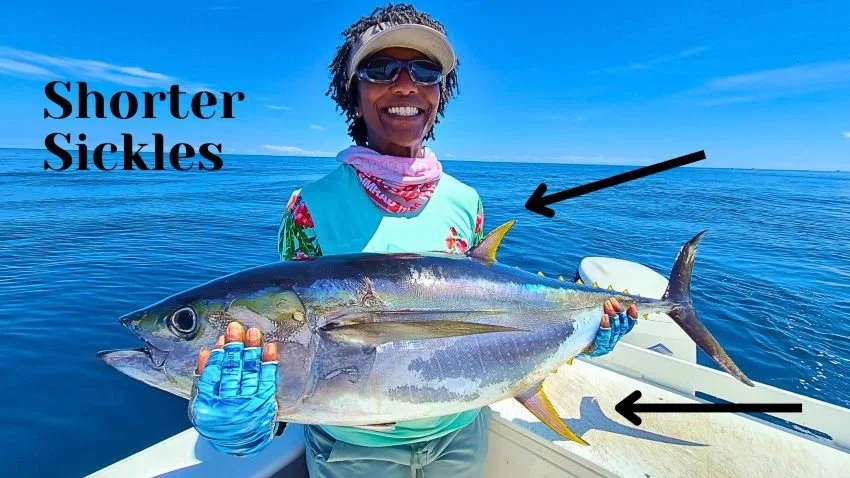Why Do the Yellowfin Tuna in Panama Have Short Sickles?
Pound for pound, the yellowfin tuna that we’ve caught in Panama are probably the strongest fish we’ve ever caught. That’s problematic because we’ve tangled with a bunch of them over 200 pounds, which effectively amounts to back-breaking labor. Trust me, the ones under 60-70 pounds are much more fun, especially on spinning gear.
In addition to being exceptionally powerful, they’re also gorgeous. A large part of that – and the thing that gives them their name – is their fins. The second dorsal fin and the anal fin, as well as the finlets between those fins and the tail, are bright yellow.
In addition to being the source of their name, the fins are also a source of their power. According to an article on LiveScience.com, citing Barbara Block, a biologist at Stanford University's Hopkins Marine Station, “tuna use their lymphatic system to control their dorsal and anal fins. Yes — the lymphatic system. This network of fluid-filled vessels and nodes, best known for producing those swollen bumps you get on your neck when you have a fever, acts like a hydraulic system to stiffen the fins and increase the tuna's mobility when they're chasing prey. That makes it “the first example of lymphatic fluids or the lymphatic system taking part in motion control in vertebrates."
In other words, their powerful fins create a system of hydraulic control which provides “an advantage in turning maneuvers undertaken during prey search, feeding and long-distance swimming, where careful energy expenditure is vital.”
If you look a many pictures or paintings of yellowfin tuna, you’ll often see long, curving dorsal and anal fins, almost all the way back to the tail. They’re commonly called “sickles” and they really make the fish look even more streamlined and powerful. However, we’ve noticed that the ones we catch in Panama typically don’t have those extra-long sickles, so I set out to see why.
Some people online speculated it was a matter of overall fish size or age, but that was quickly rebutted.
It seems that for many years, the fish with the longer sickles were thought to be a separate species. They called them “Allison Tuna,” a name given by the curator of the Bermuda Aquarium over a century ago.
Recently, however, Doug Olander at Sport Fishing Magazine provided a very good explainer on the difference between Yellowfin and Allison Tuna.
Spoiler alert: “There is none.”
Olander cited John Graves of the Virginia Institute of Marine Science as noting that longer fins only occur on larger yellowfin, but that location is a primary driver in fin length. “’There’s a lot of geographic variation in the length of these fish.’ For example, he says, across the Pacific, the relative lengths of yellowfin second dorsal and anal fins tends to increase from east to west.”
In other words, the yellowfin that you catch in one place with a dorsal and/or anal fin that is 30 or 40 percent of the overall length of the fish, is the same species as a yellowfin of the same size with much smaller fins. “It was only in the mid 1960s that the various geographic populations were combined into a single, circumglobal species,” Olander quoted Graves as saying.
In other words, the yellowfin in Panama just have different features, just as geographically separate populations of humans or other animals that may be biologically the same may have different features. Randy Newman should write a song (perhaps in Spanish) about them.







